Berlin-Brandenburg
While the hip hop culture caused a stir in the United States as early as the 1970s with DJ Kool Herc’s legendary block parties in the Bronx and the New York subways covered in spray-painted graffiti, by and large the new cultural phenomenon reached Germany later, namely in the 1980s. However, graffiti was an exception, reaching Berlin back in the 1970s. Initially, it was primarily people outside the mainstream who sprayed their messages on the walls of West-Berlin. Street art became an outlet for voices that often went unheard in society. At the end of the decade, a diverse scene with different styles and techniques emerged. The artists intervened actively in the cityscape and frequently used their works to make political statements. The Wall that divided Berlin became a canvas for their messages. In fact, graffiti and street art also existed in East Germany but the difference was that artists were subject to severe restrictions. Specifically, those artists operating in the east half of the city were obliged to commit themselves to Socialist Realism. However, although their freedom of expression was restricted, they used their art as a means of getting their ideas and visions out into the public realm. Today, the East Side Gallery, a remnant of the Berlin Wall, and crews such as the collective 1UP continue to shape the face of the city.
By contrast, it was not until the 1990s that Rap took a hold of Berlin. Kool Savas discovered Battle Rap in the United States and on returning to Germany took his inspiration from it to pen provocative lyrics and hard flows that would revolutionize German hip hop. In 1996, he founded Masters of Rap, a year later the duo Westberlin Maskulin aka Taktloss. Their uncompromising disstracks polarized and were sometimes censored, which highlighted the conflict between hip hop culture and those concerned about its damaging influence on young people. In 1997, Marcus Staiger opened the Royal Bunker and proceeded to organize open-mic sessions based on the American model in the basement pub in Berlin’s Kreuzberg district. Here, aspiring rappers could show off their talent and competed with each other. The pub closed after a year owing to rent arrears, but the Royal Bunker had already become a label and developed into the hub of Berlin hip hop with Rap legends such as Sido, B-Tight, Eko Fresh, Prinz Pi and K.I.Z., who joined the label and released influential tracks.
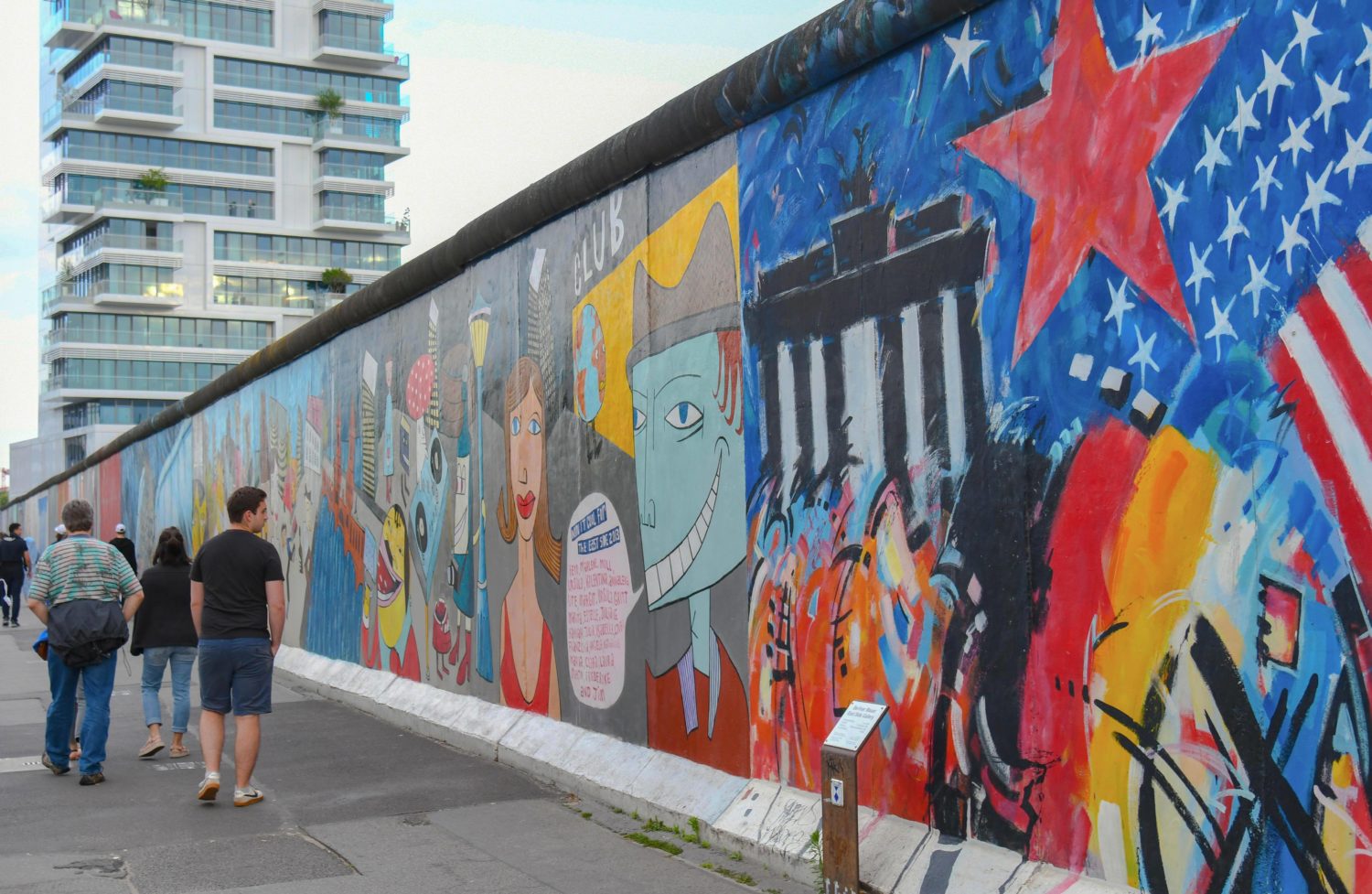
On the preserved section of the Berlin Wall, artists commented on the fall of the Wall and the political transformation. photo: Imago/Rothermel, Image via tip-berlin.de
In 2001, Specter, Spaiche and Halil set up the independent label Aggro Berlin. With Sido, B-Tight and Bushido it represented the hardest version of Gangsta Rap in Germany. Bushido’s debut album “Vom Bordstein bis zur Skyline” (2003) marked his breakthrough. His aggressive lyrics, hard flows and dramatic beats polarized but were celebrated for their honesty and authenticity. The album charted, but also sparked controversy on account of the misogynistic lyrics. In an attempt to smooth the waves, Berlin-based hip hop author Nika Kramer and New York hip hop photographer Martha Cooper initiated “W B* Girlz”: the first hip hop festival for women, which was took place in Berlin in summer 2008. Since then the scene around the Berlin female rappers has grown and with artists such as Badmomzjay, Sookee or Wa33ermann, proves that female Rap has long since earned its own place on Germany’s Rap Olympus.

Baden-Württemberg: Heidelberg
The start of hip hop in Germany was due in no small part to the US Army, members of which brought the new style back with them from their visits home and then spread it. As such, it is hardly surprising that Heidelberg, which for a long time was home to the most important US military base in Germany, is considered one of the most influential breeding grounds for hip hop in the country. One Heidelberg-based Rap band in particular was responsible for this reputation: Advanced Chemistry. Its four members Torch, Toni-L, Linguist and Gee-One, released their debut single “Fremd im eigenen Land” (Foreigner in your own Country) as a response to the racist attacks in Rostock’s Lichtenhagen quarter, and in doing so reinforced the political and socio-critical impact of the new cultural movement.
Alongside other major Rap artists such as the Stieber Twins or the female Deutschrap pioneer Cora E. (she recently guested at SCHIRN), in particular Frederik Hahn aka Torch, who DJed under the name DJ Haitian Star at the opening of THE CULTURE in the SCHIRN, is regarded in the hip hop community as the “Godfather of Hip Hop”. Through his involvement in cyphers, breakdancing and the first German freestyle rap he made a name for himself early on and helped to establish German-speaking hip hop in the country – a mission of which he has not lost sight after over 40 years of hip hop. In 2019, he agreed to make his archive material available to Heidelberg’s first hip hop archives so as to document German-language and Heidelberg hip hop culture. And it was through this action that he paved the way for UNESCO to place Heidelberg on the List of Intangible Cultural Heritage in 2023.

Saxony: Leipzig, Radebühl, Chemnitz
However, this enthusiasm for hip hop culture was not limited to West Germany; in the early 1980s it also spread to East Germany. Driven by radio and Thomas Gottschalk’s show “Na Sowas”, from 1983 onwards a small but talented hip hop scene emerged and began to rap and breakdance. The authorities and police responded to the new youth movement with skepticism; initially, public events were broken up but over time an official promotion system developed that was intended to control the small scene. A veritable hotspot for the still young breakdance scene evolved in Leipzig, although it was also sponsored and monitored by government authorities. From 1985 to 1989, the Leipzig Breakdance Workshop took place where the best bands in East Germany could compete against each other. Other key elements of the hip hop scene like MC-ing and Rap but also graffiti, had their main venue at the Rap contest organized by rapper and graffiti artist TJ Big Blaster Electric Boogie in Radebeul. After the fall of the Berlin Wall, the scene became fragmented and this together with the discontinuation of state funding initially resulted in fewer hip hop events. That said, with German rappers such as Trettmann and Kummer or the renowned Splash Festival, which took place from 1999 to 2006 in Chemnitz, a loyal Deutschrap scene has established itself in Saxony over the years.

First Breakdance-competition in Leipzig, photo: Nico Raschick/Here we come, Image via spiegel.de
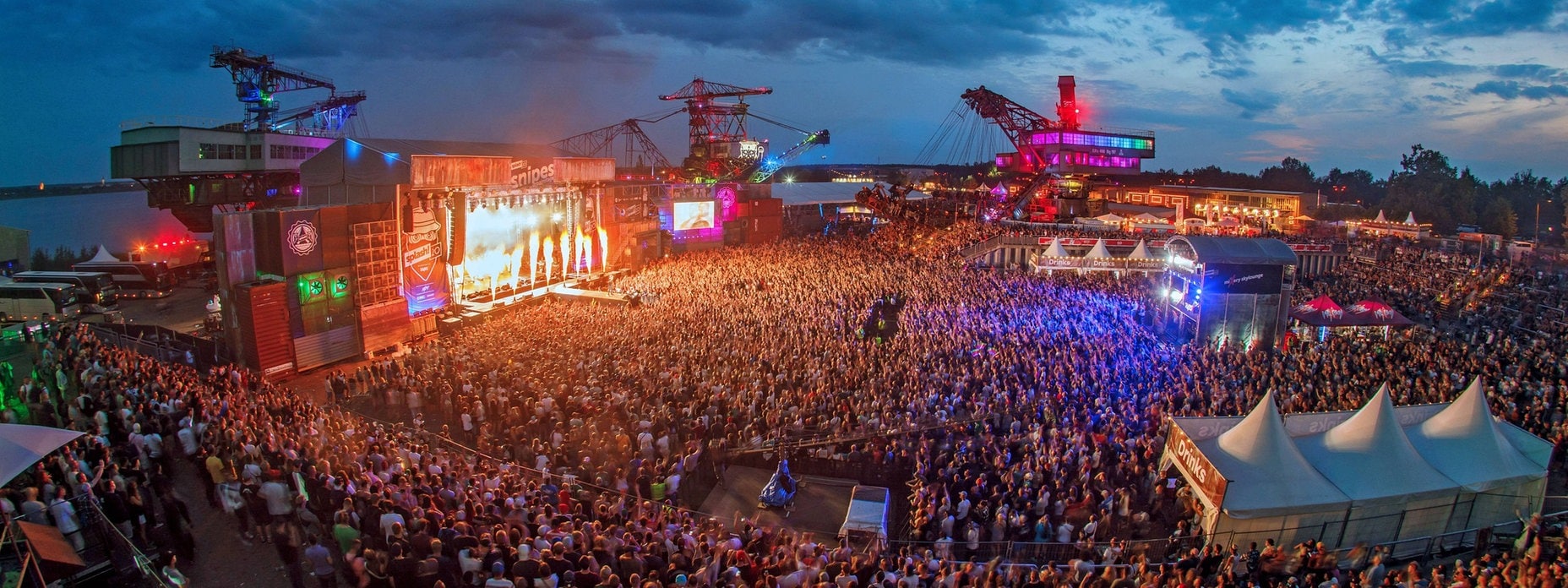
Splash-Festival, Image via mdr.de
Bavaria: Munich
While in the above cities the love of hip hop was expressed primarily in music and breakdance in Munich it was largely manifested through graffiti; it is not for nothing that the city is still referred to as the “Writer City” by those in the know. The main reason for this was an event in March 1985, which is considered a first in the still young German graffiti scene: Seven young people sprayed an entire urban train with colorful letters and comic figures – the first “German Wholetrain” was born. The city was also a pioneer in establishing so-called “halls of fame”: The walls which could be legally painted on, offered artists the opportunity to present their works without reprisals. Until 1989, Europe’s largest “hall of fame” was located on Dachauer Strasse and helped establish Munich as a center for street art. Munich still has a vibrant and varied graffiti and street art scene today. Numerous artists shape the city with their works and thus contribute to Munich’s urban flair. In terms of music, Ebow, Rua, Ali As or Fatoni are the major players setting the tone.

The first Wholtrain of Germany, photo: Cheech H/ From Here To Fame Publishing, Image via spiegel.de
Hamburg
After the rather politically informed beginnings of Deutschrap in the previous decade, in the 1990s there followed a first wave of hip hop commercialization which swept with full force over Hamburg. The Hanseatic city became the new epicenter of the deutschrap scene; the Absoluten Beginner, Fettes Brot and Dynamite Deluxe took the local charts by storm. Their message veered between fun rap and profoundness. Then in the early 2000s a counter-movement of sorts emerged with the 187 Strassenbande, consisting of the rappers Bonez MC, Gzuz, LX, Maxwell and Sa4, the producer Jambeatz as well as the sprayers Frost and Track. They shook up the scene with unfiltered gangsta rap, tracksuit bottoms, attitude and an unparalleled solidarity within the crew and have since then asserted themselves against the mainstream without having to forgo commercial success. And even today the port city has by no means ceased to be a hotspot for deutschrap: Whether unique, Haiyiti, Kwam E or Shirin David: Today’s rap artists do not shy away from making the charts – just like their predecessors in the 1990s.
Baden-Württemberg: Stuttgart and Environs
Likewise in the 1990s, the band Die Fantastischen Vier also brought a breath of fresh air to the German Rap scene. While groups in other parts of the country focused largely on political topics the Stuttgart-based four sought to create a good mood. The strategy paid off: Even before the afore-mentioned Hamburg rappers like Fettes Brot and Die Beginner, Die Fantastischen Vier were the first German Rap crew to achieve commercial success and hit the charts. However, it was precisely this success that also led to criticism in the scene. They were accused of not being “hard” or “authentic” enough.
There was more sympathy for Die Kolchose. The collective was founded in Stuttgart in 1992 and in the following years would become one of the most important front lines in the German hip hop world. It combined various players from the scene including the bands Freundeskreis, Massive Töne and Afrob, and represented the heart of Stuttgart’s hip hop and street culture scene. Their musical repertoire was characterized by a mixture of socially-critical lyrics, humorous elements, and catchy melodies. After going their separate ways for a few years, in 2012 die Kolchose performed together again at Stuttgart’s hip hop festival hip hop Open.
While Stuttgart’s Deutschrap scene has become somewhat quieter in recent years, a new hip hop nucleus seems to be emerging in the immediate vicinity: Bietigheim-Bissingen near Stuttgart is becoming increasingly important as elements, the hometown of contemporary Deutschrap greats such as RIN, Shindy and Bausa.
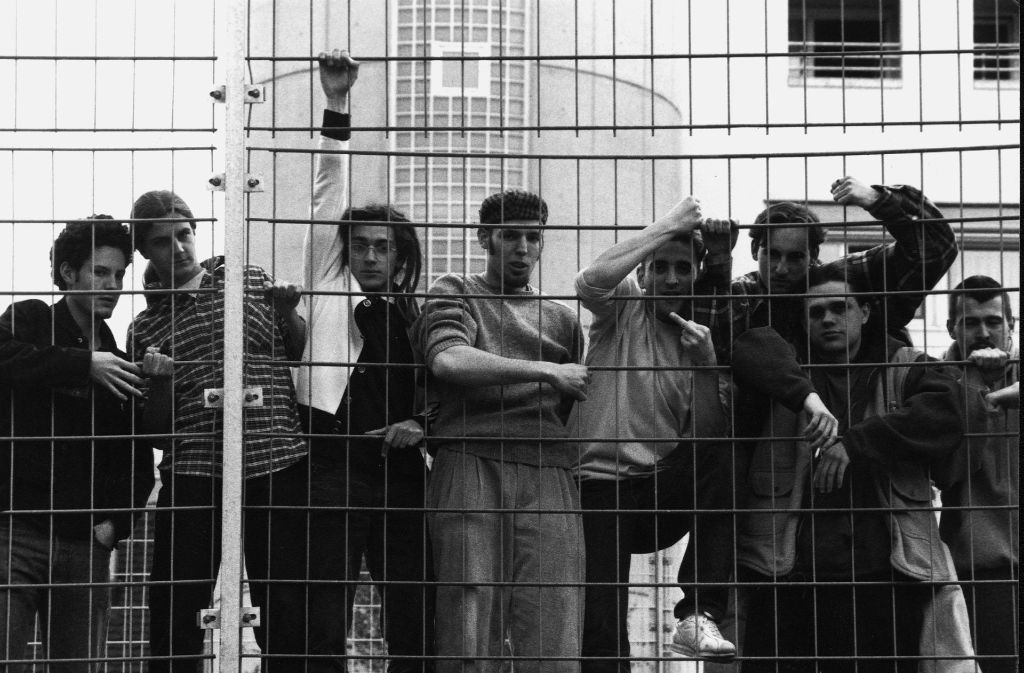
The Kolchose, 1993. From left: Max Herre, Jean-Christoph Ritter (Schowi), João dos Santos (Ju), DJ Emilio, Wasilios Ntuanoglu (Duan Wasi), DJ Friction, Mathias Bach (ZM Großmaul) and Milomir Bilbija aka. Milo, photo: Kolchose Archiv, Image via stuttgarter-zeitung.de
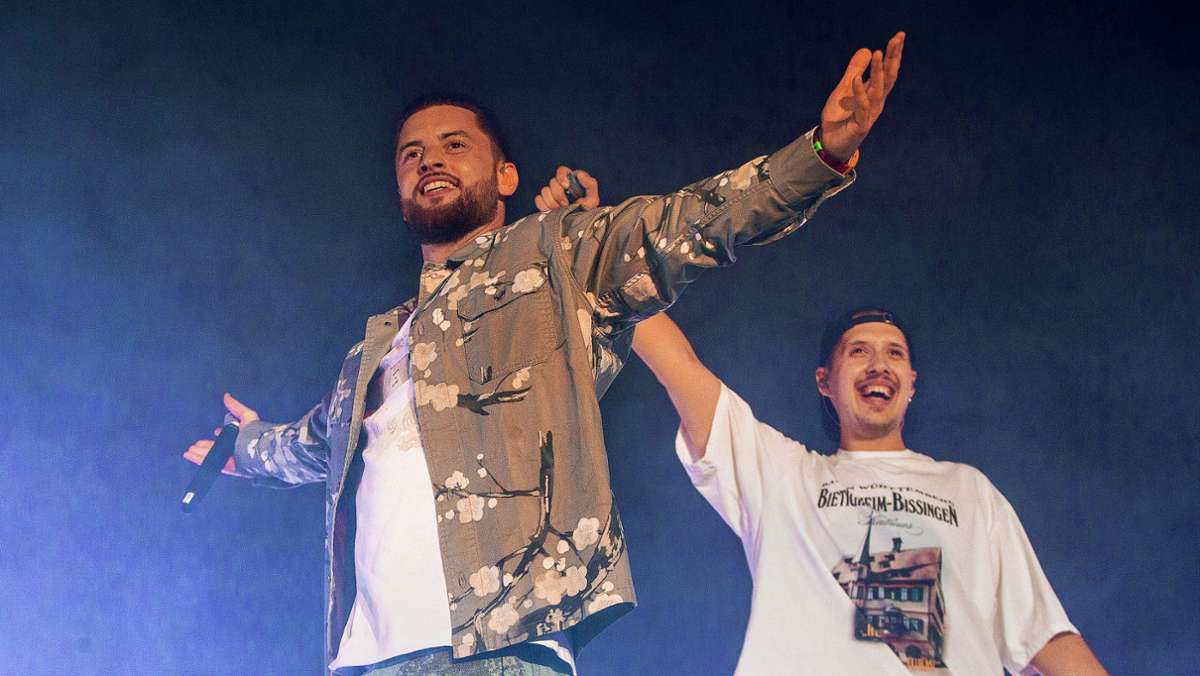
Bausa and Rin in great party mood, photo: Oliver Bürkle/Oliver Bürkle, Image via stuttgarter-zeitung.de
North-Rhine Westphalia: Cologne, Bochum, Düsseldorf, and Bonn
A strong hip hop scene also developed in North-Rhine Westphalia: As the location for the TV music channel VIVA, at the latest since the World Cup show (presented by Tyrone Ricketts) in the 1990s Cologne was characterized by a large number of hip hop events – such as DJ scratch- and beatbox world championships, festivals and Rap battles. Around the same time, namely in 1998, Ruhrpott-AG (RAG) from Bochum released its debut album “Unter Tage”, which would be a major influence for Deutschrap greats like Jan Delay, Kool Savas, Marteria or Curse. It was also about this time that a scene developed in Düsseldorf which centered more on dance and breakdance, standing out for its battle culture. Then, in 2004, it became known beyond its regional borders by staging Germany’s first urban dance battle event, the Funkin’ Stylez Festival. A few years later, rappers like Xatar and SSIO from Bonn made a name for themselves. Under the Alles oder Nix label founded by Xatar they and other artists like Schwesta Ewa spread a style of rap that refers to a criminalized life or a life that was actually criminal.
Rhine-Main region: Mainz, Frankfurt and Offenbach
The Rhine-Main region also boasts an impressive hip hop history: Due to the influence of the US military, a close-knit hip hop scene developed in Frankfurt early on. Back in the early 1980s, B-boys and B-girls associated with American Rico Sparx would meet up at Frankfurt’s central Hauptwache to compete in legendary breakdance battles, while in the city’s Funkadelic club, Funk was not the only music to be played; the first Rap parts were also performed there. In contrast to the more catchy, pop style of die Fantastischen Vier, in the banking metropolis a much harder sound established itself from the very start which was explicitly based on the reality of the streets. This was already evident in the debut album of Rödelheim Hartreim Projekt (RHP) founded by Moses Pelham and Thomas Hofman, entitled “Direkt Aus Rödelheim” (Straight from Rödelheim) which also featured Sabrina Setlur for the first time. They were the first band to be successful with a local dialect and hard beats. In the 2000s, Azad took street rap to a new level with his innovative sound and profound lyrics and eventually became one of the most influential German rappers of his generation. Almost ten years later, Haftbefehl appeared on the scene and brought about another break in Deutschrap with his unique style. His blunt directness and the candid depiction of his life in Offenbach had a lasting impact on the scene and secured his status as one of the most significant protagonists of the genre. Celo & Abdi also make a name for themselves and found the label 385idéal. Meanwhile, the hard sound and local patriotism for which all these rappers are so famous have long since influenced a new generation of Rap artists as demonstrated by Liz and Vega, but also Ramzey and OG Lu.

However, it is not only Frankfurt and Offenbach that have established a hip hop culture with nationwide appeal; Mainz and Wiesbaden also boast a flourishing graffiti and Rap scene with their own labels such as Sichtexot and events like the Meeting-of-Styles-Festival or the Tapefabrik. Indeed, many other German cities and artists have contributed to the history of hip hop in Germany, but it would have gone beyond the scope of this article to mention them all – which ones exactly? If you know the answer, you might like to add them in the comments on the article.
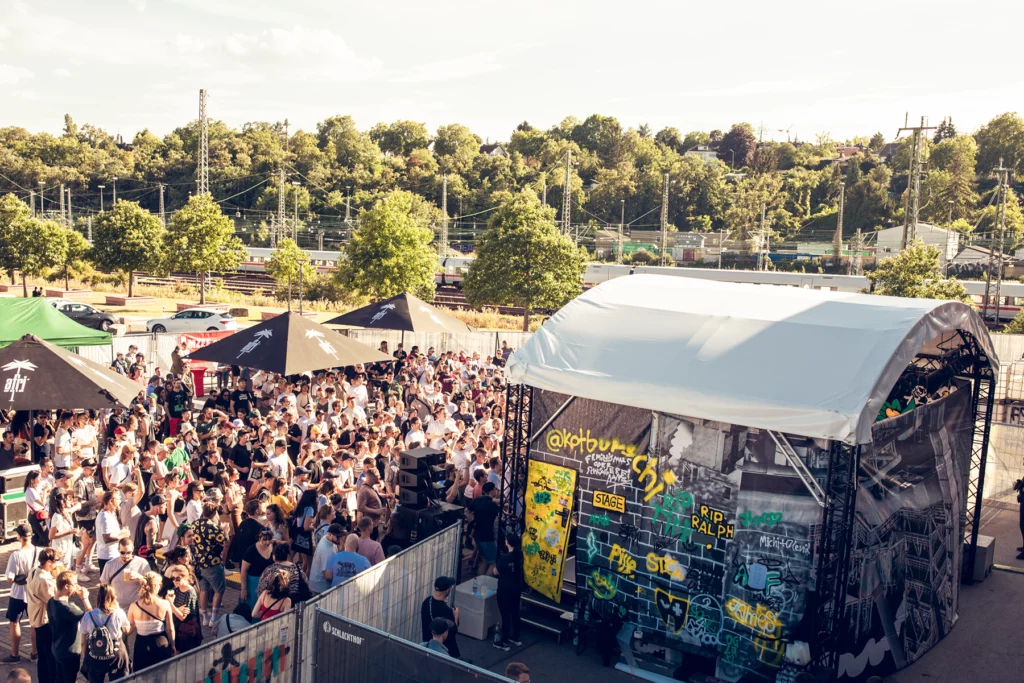
Tapefabrik, photo: David Henselder © Tapefabrik, Image via hhv-mag.com
